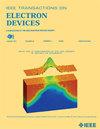Spurious-Free Shear Horizontal Surface Acoustic Wave Filters Based on 36Y-Cut LiNbO₃/SiO₂/Si Substrates
IF 2.9
2区 工程技术
Q2 ENGINEERING, ELECTRICAL & ELECTRONIC
引用次数: 0
Abstract
High-performance surface acoustic wave (SAW) filters are essential for meeting modern demands for ubiquitous wireless connectivity and rapid data transmission. This study first explores the design and optimization of shear-horizontal-SAW (SH-SAW) multilayer resonators on 36Y-cut LiNbO3/SiO2/Si substrates, addressing spurious mode suppression, energy dispersion characteristics, and filter applications. To mitigate interference between the transverse and longitudinal modes, a new tilted interdigital transducer (IDT) design and the reflector period ratio基于 36Y-Cut LiNbO₃/SiO₂/Si 基底的无杂散剪切水平表面声波滤波器
高性能表面声波(SAW)滤波器对于满足无处不在的无线连接和快速数据传输的现代需求至关重要。本研究首先探索了在36Y-cut LiNbO3/SiO2/Si衬底上的剪切-水平saw (SH-SAW)多层谐振器的设计和优化,解决了杂散模式抑制、能量色散特性和滤波器应用。为了减轻横向和纵向模式之间的干扰,实现了一种新的倾斜数字间换能器(IDT)设计和反射器周期比${\lambda }_{R}$ / ${\lambda }\lt {1}$。色散分析确定了在$1.8~\mu $ m处抑制模式的最佳波长,解决了来自瑞利和高阶SH (SH1)模式的带外(OoB)干扰。对相速度(${v}_{p}$)和能量分布的研究表明,金属层显著影响声能量耗散,降低了2 GHz以上频率的${v}_{p}$和品质因子(Q)。最后将这些发现应用于设计一个中心频率接近2ghz、分数带宽(FBW)为9.9的无杂散滤波器%, demonstrating its potential for high-performance acoustic filters in communication systems.
本文章由计算机程序翻译,如有差异,请以英文原文为准。
求助全文
约1分钟内获得全文
求助全文
来源期刊

IEEE Transactions on Electron Devices
工程技术-工程:电子与电气
CiteScore
5.80
自引率
16.10%
发文量
937
审稿时长
3.8 months
期刊介绍:
IEEE Transactions on Electron Devices publishes original and significant contributions relating to the theory, modeling, design, performance and reliability of electron and ion integrated circuit devices and interconnects, involving insulators, metals, organic materials, micro-plasmas, semiconductors, quantum-effect structures, vacuum devices, and emerging materials with applications in bioelectronics, biomedical electronics, computation, communications, displays, microelectromechanics, imaging, micro-actuators, nanoelectronics, optoelectronics, photovoltaics, power ICs and micro-sensors. Tutorial and review papers on these subjects are also published and occasional special issues appear to present a collection of papers which treat particular areas in more depth and breadth.
 求助内容:
求助内容: 应助结果提醒方式:
应助结果提醒方式:


